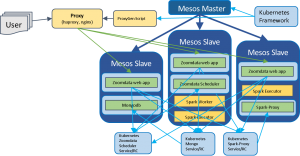































Cisco's vision for the Intercloud is to create and manage workloads across multiple clouds and to provide a single point of consumption. Nowhere is that single point of consumption stronger than at the data layer, where the diversity of datastores and the rapid progress towards real-time streaming architectures is putting huge demands on enterprises to give business users instant access to interactive queries and visualization techniques that translate quickly to value.
But the diversity of datastores, the location of data assets (on prem vs. cloud), and the volume of data has outgrown the capabilities of analytics platforms that were built for desktop and client-server deployments.
At MesosCon, Cisco is unveiling a set of partner integrations that are addressing the back-end of Internet of Things and Big Data environments from an operations / underlying hardware standpoint. And at the data analytics and visualization layer we're announcing a joint development agreement with Zoomdata to enhance their visual analytics solution to run as a collection of distributed ultra-scalable microservices running on Mesos on the Cisco Intercloud and other clouds that support Mesos. Zoomdata on Intercloud offers major advantages in workload portability and data fusion between cloud and on-premise, auto-scaling of Zoomdata clusters to support large numbers of concurrent users, and high availability and fault tolerance.

Cisco has also funded the creation of a Zoomdata Smart Connector for Cisco Data Virtualization (CiscoDV), formerly Composite Software. By joining the power of Zoomdata on Mesos, Zoomdata Fusion, Spark on Mesos via Intercloud, and CiscoDV, enterprises can perform near real-time analytics and visualizations across multiple locations by combining disparate data sources. These fused analytics can virtually tie together data sources from a single cloud, across clouds, or between cloud-hosted data and on-premise Zoomdata and CiscoDV deployments.
I'm going to be demonstrating the integrated solution stack during my keynote at MesosCon, and I look forward to having conversations with many of you about our strategic focus on microservices-based architectures and the role they can play in your application architecture and strategy
 Etiquetas calientes:
Etiquetas calientes: